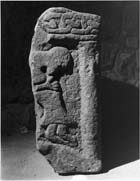Select a site alphabetically from the choices shown in the box below. Alternatively, browse sculptural examples using the Forward/Back buttons.
Chapters for this volume, along with copies of original in-text images, are available here.
Object type: Cross-base [1]
Measurements: H. (max.) 74.5 cm (29 in); W. 45.7 cm (18 in); D. (max.) 30.8 cm (12 in) Socket: (incomplete) x 22.9 x 12.1 cm (incomplete) x 9 x 4 in)
Stone type: Coarse-grained, massive yellow sandstone
Plate numbers in printed volume: Pls. 28.147-150, 29.151
Corpus volume reference: Vol 1 p. 58-59
(There may be more views or larger images available for this item. Click on the thumbnail image to view.)
A (broad): At the top a band of half pattern A is edged by a narrow flat-band moulding, and the edge is supported by a rounded columnar feature, from the base of which rises a plain curved feature. The ground is cut deeply back above, and there survives part of a composition of two figures. The one on the right is kneeling, and wears a short tunic. His head is inclined forward and is lost. Another figure clasps him round the neck and his profile head is bent forward. He has a round incised eye and appears to be bearded.
B (narrow): The top part of a band of what may be half pattern A is edged by a narrow flat-band moulding. The central panel is framed by two columnar features which are linked at the base by a convex curve of plain ground. The central panel is deeply cut back and contains a standing cross. The arm types are B11, and there is a circular incision in the centre of the cross-head.
C (broad): The top is edged by a band of half pattern A, enclosed in a narrow flat-band moulding. On the left one columnar-type edging survives, cut through by reuse; in the centre is a backward-looking animal which appears to be joined or bound to another animal or human figure. The animal head is of canine type with small pointed cars and a round eye. Its tongue is extended and interlaced.
D (narrow): Completely obliterated.
Sockets such as this and 13 have clearly some affinity with the above-ground bases of Lindisfarne 19 and 21 and Hurworth 1, but the style and execution of carving on this is clearly later. The bold deep carving is unique in its group, however. The strange rather beak-like head with incised eyes of the figure on A is most closely paralleled in the grave-marker with a warrior procession, Lindisfarne 37. The bent profile head is reminiscent also of Great Stainton 1, and the bound animal, found here and on Chester-le-Street 11, is found on Gainford 4. These two centres are also linked to Chester-le-Street by interlace types (Introduction, p. 28). It is not clear what the figure scene represents. Browne considered that it might be the return of the prodigal, a salutation, or even a wrestling scene, such as one finds on the Anglo-Scandinavian cross at Lythe, Yorkshire. The interpretation as Jacob wrestling with the angel is the most likely and the iconography is widely established on Irish and Scottish crosses of the tenth century (Introduction, p. 31).



